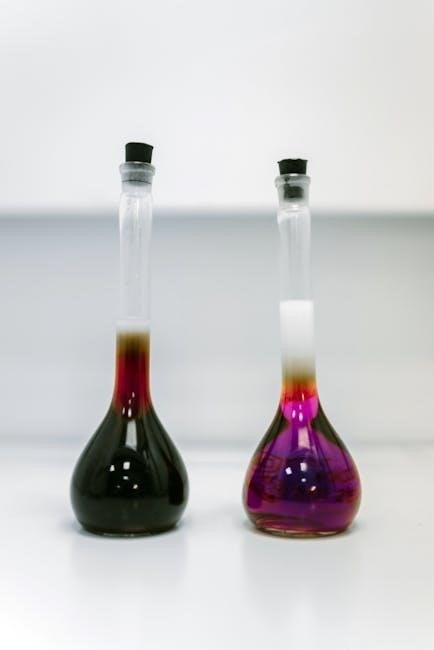Chemistry, the study of matter’s properties and transformations, focuses on understanding atoms and molecules. A Molecular Approach emphasizes chemical behavior at the molecular level, linking structure to function. This perspective is crucial for understanding reactions, materials science, and biological processes, making it foundational for fields like drug design and environmental sustainability. Chemistry: A Molecular Approach by Nivaldo Tro provides a comprehensive, visually oriented explanation of these concepts, ideal for students and researchers seeking a modern, detailed understanding of chemistry’s principles and applications.
1.1. Definition and Scope of Chemistry
Chemistry is the scientific study of matter, focusing on its composition, properties, and transformations. It explores the structure and behavior of atoms and molecules, forming the foundation for understanding chemical reactions and processes. The scope of chemistry is vast, encompassing fields like organic, inorganic, physical, and analytical chemistry. It delves into the molecular level, examining how substances interact and change. This discipline is essential for advancing materials science, pharmaceuticals, and environmental sustainability. By studying chemistry, scientists gain insights into the building blocks of life and the universe, enabling innovations that shape modern technology and improve daily life. Chemistry’s molecular approach provides a detailed understanding of these phenomena.
1.2. Historical Development of Molecular Chemistry
Molecular chemistry has evolved significantly over centuries, beginning with early theories of matter and progressing to modern understanding. The concept of molecules as the basic units of chemical reactions emerged in the 19th century, with Avogadro’s work laying the groundwork. The 20th century saw the rise of quantum mechanics, enabling detailed studies of molecular structure and bonding. Molecular orbital theory became a cornerstone, explaining how electrons behave in molecules. Advances in computational methods and experimental techniques further expanded the field. Today, molecular chemistry is a cornerstone of materials science, nanotechnology, and drug design, driving innovation and sustainability. Its historical development underscores its pivotal role in understanding and manipulating matter at the molecular level.
1;3. Importance of Studying Chemistry at the Molecular Level
Studying chemistry at the molecular level is essential for understanding the fundamental principles of chemical behavior and transformations. By examining molecules and their interactions, scientists can uncover the mechanisms driving chemical reactions, material properties, and biological processes. This knowledge is critical for advancing fields such as pharmaceutical chemistry, where molecular insights guide drug design. Additionally, molecular-level studies enable the development of advanced materials and technologies, addressing global challenges in energy and environmental sustainability. The ability to manipulate molecules also supports innovations in nanotechnology and biotechnology, showcasing the profound impact of molecular chemistry on modern science and engineering.

Key Concepts in Molecular Chemistry
Molecular chemistry explores the behavior of atoms, molecules, and their interactions; Key concepts include chemical bonding, molecular structure, thermodynamics, and quantum mechanics, forming the basis of chemical reactions and material properties.
2.1. Atoms, Molecules, and Chemical Bonding
Atoms are the building blocks of matter, consisting of protons, neutrons, and electrons. Molecules form when atoms bond, creating stable structures. Chemical bonding involves electron sharing or transfer, with covalent, ionic, and metallic bonds being primary types. Understanding bonding mechanisms is crucial for predicting molecular properties and reactivity. Chemistry: A Molecular Approach provides detailed insights into these interactions, essential for advanced studies in molecular chemistry and its applications.
2.2. Molecular Structure and Properties
Molecular structure determines the properties and behavior of substances. It includes molecular geometry, polarity, and the distribution of electrons. Understanding molecular structure is crucial for predicting solubility, reactivity, and physical properties. Computational methods, such as quantum chemistry, are used to model molecular structures and analyze their properties. These insights are essential for designing materials and understanding biological systems. Chemistry: A Molecular Approach provides detailed explanations of molecular structure and its impact on chemical behavior, aiding students in grasping fundamental concepts and their practical applications in fields like drug design and materials science.
2.3. Chemical Reactions and Stoichiometry
Chemical reactions involve the transformation of substances, governed by stoichiometry, which quantifies the relationships between reactants and products. Stoichiometry is essential for balancing chemical equations and calculating molar masses, moles, and concentrations. It also predicts the theoretical yields of reactions, aiding in experimental design and optimization. Understanding stoichiometric principles is critical in fields like pharmaceutical chemistry and materials science. Resources like Chemistry: A Molecular Approach provide detailed explanations and practical examples to master these concepts, ensuring accuracy in laboratory work and real-world applications. This foundational knowledge enables chemists to analyze and predict the outcomes of chemical processes efficiently.

Molecular Orbital Theory
Molecular Orbital (MO) Theory explains how atomic orbitals combine to form molecular orbitals, determining a molecule’s electronic structure and bonding properties. It provides insights into chemical bonding, reactivity, and molecular stability, essential for understanding molecular interactions and spectroscopy. Resources like Chemistry: A Molecular Approach offer detailed explanations and applications of MO Theory, aiding students and researchers in mastering this fundamental concept in modern chemistry.
Molecular Orbital (MO) Theory is a fundamental concept in chemistry that describes how atomic orbitals combine to form molecular orbitals in a molecule. Unlike valence bond theory, MO theory provides a more comprehensive understanding of molecular electronic structure, emphasizing the delocalization of electrons across the entire molecule. The theory explains the formation of bonding and antibonding orbitals, which determine the stability and reactivity of molecules. By analyzing molecular orbitals, chemists can predict properties such as bond order, magnetic behavior, and spectroscopic characteristics. Resources like Chemistry: A Molecular Approach by Nivaldo Tro offer detailed explanations and visualizations of MO Theory, making it accessible for students and researchers alike. This theory is essential for understanding advanced topics in quantum chemistry and materials science.
3.2. Bonding and Antibonding Orbitals
In molecular orbital theory, bonding and antibonding orbitals are formed when atomic orbitals combine. Bonding orbitals have lower energy and increased electron density between nuclei, stabilizing the molecule. Antibonding orbitals, with higher energy and nodes between nuclei, destabilize the molecule. The filling of these orbitals follows the Aufbau principle, with electrons occupying bonding orbitals first. The difference in energy between bonding and antibonding orbitals determines molecular stability and reactivity. For example, in O₂, the filling of antibonding orbitals leads to paramagnetism. Chemistry: A Molecular Approach by Nivaldo Tro provides detailed explanations and visualizations of these concepts, aiding in understanding molecular behavior and reactivity.
3.3. Applications of Molecular Orbital Theory
Molecular Orbital Theory (MOT) has wide-ranging applications in understanding chemical bonding, reactivity, and molecular design. It is instrumental in drug design, where it helps predict molecular interactions and optimize drug candidates. In materials science, MOT aids in designing materials with specific electronic and structural properties. Environmental chemistry benefits from MOT as it models pollutant behavior and aids in sustainability efforts. Additionally, MOT is used in spectroscopy to interpret molecular spectra and in quantum chemistry for computational modeling. Chemistry: A Molecular Approach by Nivaldo Tro explores these applications, providing insights into how MOT advances research and innovation across diverse scientific fields.

Thermodynamics and Molecular Processes
Thermodynamics and Molecular Processes explores energy transformations, molecular interactions, and equilibrium. It discusses entropy, free energy, and the second law, linking macroscopic and microscopic phenomena in chemical systems.
4.1. Thermodynamic Principles
Thermodynamic principles form the foundation for understanding energy and its transformations in chemical systems. The first law introduces the conservation of energy, while the second law explains entropy, a measure of disorder. These laws govern molecular processes, such as heat transfer, work, and energy exchange. In Chemistry: A Molecular Approach, Tro emphasizes the application of thermodynamic principles to predict reaction spontaneity and calculate Gibbs free energy. Molecular-level insights reveal how energy changes drive chemical reactions and determine system stability. This section provides a comprehensive framework for analyzing energy interactions at the molecular scale, essential for modern chemistry studies.

4.2. Energy Changes in Chemical Reactions
Energy changes are central to understanding chemical reactions, as they determine whether processes are endothermic (absorbing energy) or exothermic (releasing energy). These changes involve the breaking and forming of chemical bonds, with activation energy acting as the threshold for reactions to occur. Thermodynamic principles, such as enthalpy and Gibbs free energy, quantify these transformations. In Chemistry: A Molecular Approach, Tro explains how energy changes at the molecular level dictate reaction spontaneity and equilibrium. This section provides tools to calculate and interpret energy shifts, enabling predictions about reaction outcomes and conditions for optimal energy efficiency in various chemical and industrial processes.
4.3. Entropy and the Second Law of Thermodynamics
Entropy, a measure of disorder or randomness, is a critical concept in thermodynamics. The second law states that the total entropy of an isolated system never decreases, driving spontaneous processes. In Chemistry: A Molecular Approach, Tro explains how entropy influences chemical reactions, emphasizing its role in determining the direction and feasibility of processes. At the molecular level, entropy is linked to the distribution of energy and the number of accessible microstates. Understanding entropy is essential for predicting reaction outcomes and optimizing energy efficiency in various systems. This section provides a detailed exploration of entropy’s principles and applications in molecular chemistry.

Quantum Chemistry and Molecular Modeling
Quantum chemistry applies quantum mechanics to study molecular behavior, enabling precise modeling of chemical structures and reactions. Computational methods in molecular modeling simulate molecular interactions, aiding in drug design and materials science advancements.
5.1. Basics of Quantum Mechanics in Chemistry
Quantum mechanics provides the foundation for understanding chemical phenomena at the atomic and subatomic level. It explains the behavior of electrons, nuclei, and their interactions, forming the basis of molecular structure and bonding. Key principles include wave-particle duality, the uncertainty principle, and the quantization of energy. These concepts are applied to study atomic orbitals, electron configurations, and chemical reactions. Quantum mechanics is essential for understanding the probabilistic nature of electron distribution, which governs chemical bonding and reactivity. Computational methods in quantum chemistry use these principles to model molecular systems, enabling predictions of chemical properties and reaction mechanisms. This knowledge is vital for advancing fields like drug design, materials science, and catalysis.
5.2. Computational Methods in Molecular Modeling
Computational methods in molecular modeling are essential tools for simulating and predicting molecular behavior. These techniques use algorithms to calculate molecular properties, such as energy, structure, and reactivity. Methods like molecular dynamics, Monte Carlo simulations, and quantum mechanical calculations are widely applied. Density functional theory (DFT) and semi-empirical methods are also used to study molecular interactions and reaction mechanisms. These computational approaches enable researchers to design new materials, drugs, and catalysts. By combining experimental data with theoretical models, chemists can gain insights into complex molecular systems. Computational methods are integral to advancing research in chemistry, offering precise predictions and accelerating discovery in fields like pharmaceuticals and materials science.
5.3. Applications of Quantum Chemistry
Quantum chemistry has diverse applications across various fields, revolutionizing molecular-level research. It is instrumental in drug design, enabling the creation of targeted therapies by modeling molecular interactions. In materials science, quantum methods predict properties of nanomaterials and catalysts, aiding in their development. Environmental chemistry benefits from simulations of chemical reactions and pollutant behavior. Additionally, quantum chemistry enhances spectroscopy and reaction dynamics studies, providing insights into molecular mechanisms. Its integration with computational tools has accelerated advancements in energy storage and electronics. By offering precise molecular-level insights, quantum chemistry drives innovation in healthcare, technology, and sustainability, making it a cornerstone of modern chemical research and development.

Advanced Topics in Molecular Chemistry
Advanced topics include molecular dynamics, quantum simulations, and nanomaterials. These methodologies enable precise modeling of molecular interactions and material properties, revolutionizing drug design and spectroscopy applications.
6.1. Molecular Dynamics and Simulation
Molecular dynamics (MD) and simulation are powerful tools in molecular chemistry, enabling researchers to model atomic and molecular movements over time. These computational methods provide insights into structural changes, thermodynamic properties, and reaction mechanisms. By simulating systems at atomic scales, scientists can predict material behaviors and optimize chemical processes. Advanced algorithms and high-performance computing have made MD accessible for studying complex systems, from biological molecules to nanomaterials. Such simulations are essential for drug discovery, understanding protein folding, and designing advanced materials, bridging theoretical and experimental chemistry effectively.
6.2. Spectroscopy and Molecular Analysis
Spectroscopy is a cornerstone of molecular analysis, enabling the identification and characterization of molecular structures. Techniques like IR, NMR, and mass spectrometry reveal how molecules interact with energy, providing insights into their composition and properties. These methods are essential for understanding chemical reactions, verifying compound identities, and studying molecular interactions. Advanced spectroscopic tools allow researchers to analyze complex systems, from biological molecules to nanomaterials. By linking molecular structure to spectral data, spectroscopy drives advancements in fields like drug discovery, environmental monitoring, and materials science, offering precise and non-destructive ways to probe molecular behavior and composition.
6.3. Advanced Materials and Nanochemistry
Advanced materials and nanochemistry focus on designing and synthesizing materials at the molecular and nanoscale levels. These materials exhibit unique properties, such as enhanced strength, conductivity, or optical behavior, due to their tailored structures. Nanochemistry leverages techniques like chemical vapor deposition and sol-gel processing to create nanomaterials with applications in electronics, medicine, and energy storage. The molecular approach ensures precise control over material composition, enabling breakthroughs in fields like quantum dots, graphene, and biomaterials; By understanding molecular interactions, scientists develop innovative materials that address global challenges, from sustainable energy solutions to advanced medical devices, showcasing the transformative potential of chemistry at the nanoscale.

Applications of Molecular Chemistry
Molecular chemistry drives advancements in materials science, pharmaceuticals, and environmental sustainability. It enables the design of novel materials, targeted drugs, and sustainable solutions, transforming industries and daily life.
7.1. Materials Science and Engineering
Molecular chemistry plays a pivotal role in materials science and engineering by enabling the design and synthesis of advanced materials. From nanomaterials to biomaterials, molecular-level understanding allows for tailored properties, enhancing performance and sustainability. Techniques like chemical vapor deposition and sol-gel processes, rooted in molecular chemistry, have revolutionized electronics and ceramics. The development of carbon nanotubes and polymer composites exemplifies how molecular approaches drive innovation. By controlling molecular interactions, scientists create materials with unique mechanical, thermal, and electrical properties, addressing challenges in energy storage, aerospace, and medicine. This field continually evolves, offering solutions to global demands for stronger, lighter, and more efficient materials.
7.2. Pharmaceutical Chemistry and Drug Design
Pharmaceutical chemistry leverages molecular approaches to design and develop therapeutic agents, focusing on the interaction between drugs and biological targets. Molecular modeling and computational methods enable the creation of compounds with high specificity and efficacy. Click chemistry and protein dimerization techniques are powerful tools in drug design, allowing for precise modulation of protein functionality. By understanding molecular mechanisms, chemists optimize drug potency, reduce side effects, and improve bioavailability. Advances in quantum chemistry and molecular dynamics simulations further accelerate drug discovery, aiding in the development of treatments for diseases. This field bridges chemistry and medicine, transforming molecular insights into life-saving therapies.
7.3. Environmental Chemistry and Sustainability
Environmental chemistry applies molecular principles to address ecological challenges, focusing on pollution mitigation and sustainable practices. Molecular approaches help understand the behavior of pollutants in air, water, and soil, enabling the design of remediation strategies. Advanced materials and green chemistry techniques minimize environmental impact by reducing waste and energy consumption. Quantum chemistry simulations aid in predicting the environmental fate of chemicals, while molecular modeling informs the development of eco-friendly technologies. By integrating molecular insights, chemists contribute to global sustainability, ensuring a healthier planet for future generations through innovative, environmentally responsible solutions.

Educational Resources and Study Materials
Chemistry: A Molecular Approach offers comprehensive resources, including PDF textbooks, solution manuals, and online tutorials. These materials provide detailed explanations, practice problems, and visual aids, aiding students in mastering complex concepts. Supplementary guides and digital tools enhance learning, ensuring a thorough understanding of molecular chemistry principles and applications. These resources are essential for both independent study and classroom instruction, supporting academic success in chemistry.
8.1. Chemistry: A Molecular Approach PDF
The Chemistry: A Molecular Approach PDF by Nivaldo J. Tro is a widely used resource for studying chemistry at the molecular level. Available in its 5th edition, this eBook provides a detailed, visually oriented approach to understanding chemical principles. Students and researchers can access the PDF through platforms like ResearchGate, chemistry forums, or educational websites. The document covers foundational concepts, molecular structures, and advanced topics, making it a comprehensive tool for learning. Supplementary materials, such as solution manuals, further enhance its utility. This PDF is essential for those seeking a modern, in-depth understanding of chemistry’s molecular aspects.
8.2. Solution Manuals and Supplementary Materials
Supplementary materials, including solution manuals, are essential resources for mastering Chemistry: A Molecular Approach. These manuals provide detailed solutions to textbook problems, aiding students in understanding complex concepts and improving problem-solving skills. Available for editions like the 4th and 5th, they can be accessed through educational websites, forums, or specific chemistry platforms. Additional materials, such as tutorial guides and study aids, further enhance learning. These resources are invaluable for both students and instructors, offering comprehensive support for the molecular approach to chemistry. They ensure a deeper grasp of the subject matter, making them indispensable for academic success.
8.3. Online Tutorials and Study Guides

Online tutorials and study guides are invaluable for understanding Chemistry: A Molecular Approach. Platforms like ResearchGate and educational forums offer downloadable resources, including tutorial guides and interactive simulations. These tools enhance comprehension of molecular chemistry concepts and provide practical examples for complex topics. Many study guides are available as PDFs, making them easily accessible for self-study. Additionally, video tutorials and web-based courses complement the textbook, offering visual and auditory learning experiences. These resources cater to diverse learning styles, ensuring students can grasp foundational and advanced chemistry concepts effectively. They are particularly useful for reinforcing theoretical knowledge and preparing for exams or research projects.
Chemistry: A Molecular Approach provides a comprehensive understanding of molecular interactions and their significance in modern science. By studying molecular chemistry, students gain insights into the fundamental principles driving chemical reactions and material properties. This knowledge is essential for advancing fields like pharmaceuticals, materials science, and environmental sustainability. The availability of resources such as PDFs and supplementary materials ensures accessibility for learners worldwide, fostering a deeper appreciation of chemistry’s molecular foundations and its future potential.
9.1. Summary of Key Concepts
Chemistry: A Molecular Approach emphasizes understanding matter through molecular interactions. Key concepts include atomic structure, chemical bonding, and molecular orbital theory. These principles explain chemical reactions, thermodynamics, and quantum mechanics’ role in molecular behavior. The text integrates theoretical foundations with practical applications, such as materials science and pharmaceutical chemistry. By focusing on molecular-level processes, it provides a detailed framework for analyzing chemical systems. Resources like the Tro PDF and supplementary materials support comprehensive learning, ensuring students grasp the interconnectedness of molecular chemistry concepts and their real-world implications, from drug design to environmental sustainability.
9.2. Future Directions in Molecular Chemistry
Molecular chemistry is advancing rapidly, driven by emerging fields like quantum computing and artificial intelligence. These technologies enhance molecular modeling and simulation, enabling precise predictions of molecular behavior. Sustainability is another key focus, with efforts to develop eco-friendly materials and energy-efficient processes. The integration of click chemistry and biomimetic approaches is revolutionizing drug design and materials synthesis. Additionally, the study of molecular dynamics at nano scales is opening new avenues in nanochemistry and biotechnology. Resources like Chemistry: A Molecular Approach PDF and computational tools are equipping researchers to explore these frontiers, ensuring molecular chemistry remains at the forefront of scientific innovation and problem-solving.
